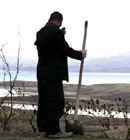Society
Dam forces relocations of 300,000 more
By Wang Huazhong (China Daily)
Updated: 2010-01-21 08:10
 |
Large Medium Small |
300,000 more people will have to move to escape land hazards
|
 Local residents in Shuangjiang town, Yunyang county of Chongqing, search for reusable steel bars and bricks in a dismantled building on Sep 21, 2009. They can make 100 yuan ($15) to 200 yuan each per day by collecting materials that can be recycled. [Rao Guojun/China Daily]
|
CHONGQING: At least another 300,000 people living near the Three Gorges Dam will have to be relocated to protect the environment. This is in addition to the 1.138 million people already relocated for the world's largest hydropower project, a local migration official said yesterday.
As part of the nation's strategy to provide cheap energy and prevent flood and draught, the project began in 1992 and began water reserving and hydro-electricity harnessing in 2008. Officials have "basically" finished the first phase of resettling about 1.3 million people in Chongqing and Hubei province, a local government work report said.
"A total 54.18-billion yuan investment has been designated to facilitate the migration project that helped 1.138 million displaced Chongqing people settle down," Chongqing acting mayor Huang Qifan said at an ongoing annual conference of the city's People's Congress.
However, the deputy director of the migration bureau of the heavy-weighted Wanzhou district of Chongqing, which used to be home for one-fifth of the total migration population, told China Daily yesterday that at least another 300,000 people would have to move out of the reservoir area.
"Additionally, more people will have to move out of the area to avoid geographic hazards, like landslides, caused by the dam that tames water levels rising or falling between 145 m to 175 m every year to produce electricity."
He said the actual number depends on the assessment of the geology of the dam area.
According to Hu, ecology protection and hazards prevention are just two major tasks of a proposed follow-up dam project, which also has to address legacy problems from the early migration period, the need for job training of the migrants, and economic development of the area to create new jobs.
The Three Gorges Project Construction Committee Executive Office under the State Council had designated the Yangtze River Water Resources Commission to draft a general plan for the next 10 years.
"This is not a proposal from local to central government, but a general plan the State Council is pushing forward. Therefore, it is very likely to be taken into action soon," Hu said.
Hu revealed the plan has been submitted to the State Council, and is expected to be carried out in 2010 and get its budget "that would be no less than the previous 40 billion yuan to compensate migrants during the dam-building period".
But one problem is that the new migrants will cause even more overcrowding in the area near the dam.
According to a 2009 survey conducted by the Chongqing Committee of Chinese People's Political Consultative Conference (CPPCC), population density in the reservoir area has reached 338 people per sq km, which is 2.1 times the national average.
The report also said "land for industrial use is lacking."
Many people living in the submerged reservoir area reportedly have already relocated to neighboring provinces or cities downstream of the river.
Also, rampant geographic hazards threaten the reservoir area.
A survey by relevant authorities in 2007 found 9,324 sites were potentially threatened by geographic hazards, including 3,812 new ones that have emerged since 2003 because of water reserving and rainfalls, according to the latest report from the Chongqing committee of CPPCC.
The report said that since 2001, some 53,025 people have been resettled to avoid the hazards.
In addition, 243 dangerous geographic problems occurred around the Chongqing section of the reservoir area since 2008, the report said.
About 22,355 people have been affected by those cases, which caused 640 million yuan in damage, the report said.
In the next three years, bank slumps and landslides are likely, while the problem of bank slumps will continue for the next 20 years, the report said.
The Jiusan Society yesterday also proposed during the annual session of the Chongqing committee of the CPPCC to create a new mechanism that prevents and mitigates hazards.
"The incumbent mechanism lacks foresight and focus. It remedies rather than prevents," said Chen Hongkai, a member of the advising body who led the drafting of the proposal.












